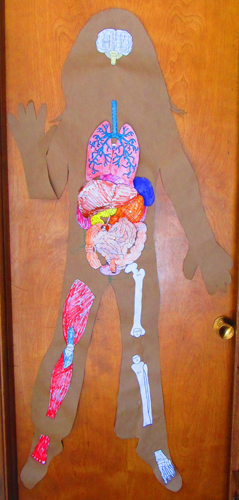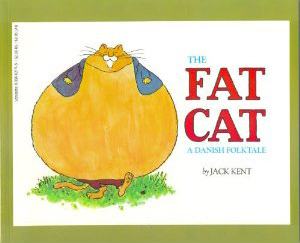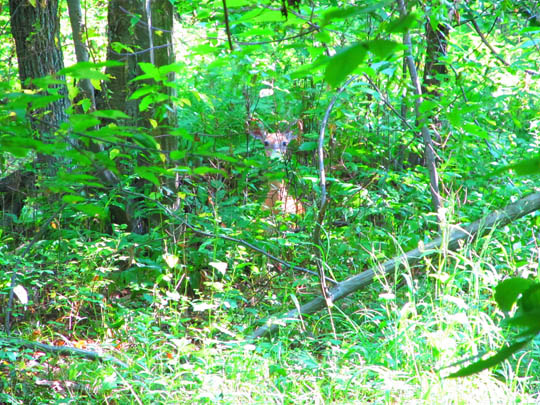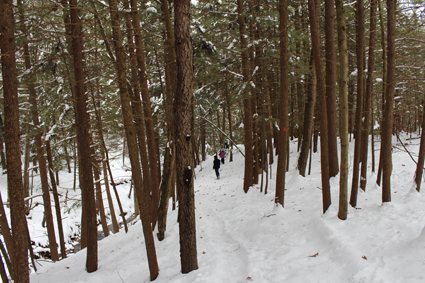B, B, Biology
I’ve been searching for a different look, so don’t be surprised if Across the Page looks different every time you stop in. My blog is a little like my hair: I may get it cut in different ways, but somehow it always ends up looking basically the same. On the blog, that means a big banner image at the top, text below. I’d actually like to find something that’s a bit less image-heavy, a bit quieter and content-centric, but not totally boring.
But what I really wanted to write about is the co-op class I’ve been teaching to a group of lively and brilliant K-1 boys and girls. I feel good about the class, although it has felt a little less “seriously scientific” than the chemistry class I taught last year using a combination of materials from Real Science-4-Kids and Ellen McHenry’s Basement Workshop. Instead of “experiments,” I’d call what we’ve done “activities.”
 For instance, the spine for the course (such a great metaphor for a human body class) has been Patty Carratello’s My Body, which includes an information page and coloring page for each organ studied. We’ve learned the information, made copies of the info pages for each student to make a notebook using brass fasteners, and colored, cut, and pasted the organs on body-tracings we made the first day of class. As a result the order of study has been determined by the logic of these body-tracings: brain has to go under the face, heart has to go under the lungs, etc. It hasn’t been as body-system focused as cutting-pasting focused, so I’ve been taking time to review as we approach the end so we can get a better sense of the coherence of the body’s workings.
For instance, the spine for the course (such a great metaphor for a human body class) has been Patty Carratello’s My Body, which includes an information page and coloring page for each organ studied. We’ve learned the information, made copies of the info pages for each student to make a notebook using brass fasteners, and colored, cut, and pasted the organs on body-tracings we made the first day of class. As a result the order of study has been determined by the logic of these body-tracings: brain has to go under the face, heart has to go under the lungs, etc. It hasn’t been as body-system focused as cutting-pasting focused, so I’ve been taking time to review as we approach the end so we can get a better sense of the coherence of the body’s workings.
The activities, beyond cutting and coloring and pasting, have come from How the Body Works and Head to Toe Science. A few weeks we haven’t been able to come up with much. The gall bladder and pancreas are sadly neglected in the world of children’s science, poor organs. And the library shelves are not overflowing with books on the spleen. We managed those weeks by incorporating some review.
The week on cells, my dad and mom came to class. Dad is a retired biology teacher, and he led the class in making slides of epithelial cells and then examining them under the microscope. We looked at some onion cells too. That was probably our most properly scientific class — the other activities have been more like simulations of how organs do what they do.
The last few weeks we’ve played human body Bingo. A box of dollar store prizes is incredibly motivating! And I brought in Fred, our human body poster from here at home. It was part of a Magic Schoolbus science kit that really wasn’t worth the money, but we’ve been using it to play a version of pin the tail on the donkey — more like pin the scalpel on Freddie — and the kids tell a fact about whatever organ the pointer lands on. We have just this week (skin) and next week (face, eyes, ears, smell) left. Tomorrow I’m going to set them working on thinking caps in recognition of all the great brain work they’ve done during the semester!
 Last but not least, I’ve tried to incorporate some stories and books into our time together. I read The Fat Cat, an old favorite around here that offers a fanciful interpretation of the digestive system. Maybe you know it — does this ring a bell?
Last but not least, I’ve tried to incorporate some stories and books into our time together. I read The Fat Cat, an old favorite around here that offers a fanciful interpretation of the digestive system. Maybe you know it — does this ring a bell?
I ate the gruel and the pot and the old woman too
and Skohottentot
and Skolinkenlot
and now I am going to also eat you!
Very fun story, full of Going-On-A-Bear-Hunt-esque repetition.
Some have been nonfiction, such as What Happens to a Hamburger. Tomorrow I’ll read The Magic Schoolbus Explores the Senses. I looked for The Saggy Baggy Elephant as my segue into skin, but can you believe it? Our library system doesn’t have a single copy. (Any suggestions, blogosphere? There’s still time for a library trip before class…)
I find that reading — even if the relevance is, um, tangential — is a great way of quieting busy limbs and bringing minds into focus. And no matter what it is, they love being read to.
All in all it’s been an enjoyable semester together, and I hope they’ve learned something. They’re enthusiastic, so even if that’s all they take away, it’s a good start. In fact, my younger daughter is in the class and made up a chant: “B, B, Biology! Studying the bodies of you and me!” Now if only I could find a way to teach science as effectively at home, with just a few of us, as it’s possible to do with a larger group. It’s a subject that works better for me in a group setting than one-on-one.



8 Comments
Carrie, Reading to Know
Both my parents and Jonathan’s parent’s used the My Body book with us when we were growing up and we already have our copy to use with our own kids! =D It’s such a fun activity.
Amy @ Hope Is the Word
Great post, Janet. Studying the human body is my girls’ favorite science-y thing to do, and they’ve already requested a study again this year even though we did it last year.
Hmmm. . .I’ll try to think of a book on skin and come back let you know if I do.
Janet
That would be great… Magic Schoolbus books aren’t my favorite to read aloud!
JW
Since you were recently talking about the Kindle (a lot!) and strong female characters I thought you might like this book: http://www.amazon.com/Letters-Woman-Homesteader-ebook/dp/B000JQU1YK/ I have started it on my “kindle” (software not the actual device) and she is so charming and witty and really a character! It is free. Enjoy! So far I am liking it a bit better than: http://www.amazon.com/Ladys-Life-Rocky-Mountains-ebook/dp/B000FC1DYK/
Sheila
You might be able to find the Saggy Baggy Elephant at a thrift store. Not sure if you have enough time for that.
My son (2nd grade) recently went on a field trip to see “Bodyology” with Slim Goodbody. Fun way to learn biology – songs, etc.
Janet
That does sound fun! We could have used some good songs.
Ruth
I remember The Fat Cat! Haven’t seen that in years! We also had The Saggy Baggy Elephant but I don’t have a copy now. Hope you find it!
Janet
You’re the first person I’ve met who knows The Fat Cat! :-)
There is actually a version of The Saggy Baggy Elephant on YouTube. That’s the only “free copy” I’ve been able to see this week.